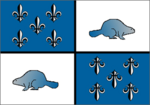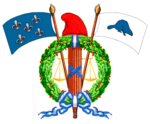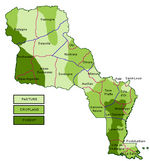Louisianne
| National motto: Toujours Libre, Toujours Amicable, Toujours Fraternel. | |
| National Hymn: Louisianne | |
| Languages | |
| Official | Francien (Louisiannais) |
| Other | English, Brithenig, Navarran, Gaulhòsc (Primarily Narbonosc, but all Langues d'Oc are represented), Biloxien |
| Capital | Paris-sur-Mizouri |
| Important Cities | Baton Rouge, Lyons-sur-Mizouri, Pamplona, Narbo, Saint-Louis, Chambeon, Zarahemla, Toulouse, Brest, Nouvelle Orléans |
| First President | Marie-Claire Gildersleeve |
| Area | ... |
| Population | 22.446.397 |
| Independence | from France |
| (declared) | never |
| (de facto) | 1820's - 1840's |
| (recognized) | 1950's |
| Currency | 1 Écu = 10 décîmes = 100 centîmes |
| Organizations | KSD, ATOE, Interpol |
Often referred to as the land between the great rivers, Louisianne stradles much of the North American plains, with a varied population and language-base. It varies in climate from Alpine Tundra to Coastal Bayou, with verdant rolling fields of corn, soy and other crops.
General information
The Republic of Louisianne began as a colony of France, but some time after the Revolution, it acceded to independence, and has hence remained its own. It was not until after the Second Great War that France belatedly acknowledged the formal independence of its last North American colony, despite their otherwise normal international relations. A minor ceremony was made with a titular deed signed over to the people of Louisianne from President Vincent Auriol on 1 May, 1951.
Louisiana comprises the former French territory in middle North America. It borders on Tejas and the Solemn League. To the west, it borders on the disputed territory of Deseret which Tejas and Alta California have squabbled over for more than a century.
Administration
Government
For a full description of the government, see the main article Louisianne Government.
Louisianne can be described as a highly decentralized Republican Oligarchy, as the Préfects and First President oversee the country's national legislation and policy, but each Département and Préfecture maintain a high level of independence.
Louisianne staunchly holds against the death penalty for perpetrators of capital crimes, as do many nations.
Louisiannan government agencies include CNEL, or Comité National de l'Espace Louisiannais, BMN or the Bureau Météorologique National.
Louisianne also has several state-sponsored humanitarian agencies. Le Patrimoine is a nationalistic agency geared to develop pride in Louisianne. Le Régiment de la Paix is less dependent on the Louisiannan government and is now a multinational entity, but was incepted by Jean-Francois Young.
For a list of Louisiannan political parties, please see: Political Parties of Louisianne.
Administrative Divisions
Louisianne's Administrative divisions are based upon the divisions enacted by the French Revolution. Louisianne is the only 'daughter' nation of France that has retained the divisions, divisions which even France herself has not retained. While Louisianne claims to remain entirely true to these divisions, this is incorrect, as they have modified the divisions through centuries of use.
Louisianne is divided into Préfectures, Départements, Comtés, Arrondissments and Communes. The 6 Préfectures are Osage, Nouvelle Cournouaille, Nouvelle Gaulle, Nouvelle Navarre, Saint-Louis, Saint-Onge.
These préfectures are divided into 22 départements. Each of these is divided into arrondissments and further into canton or commune.
- Osage (Yellow)
- Nouvelle Cournouaille (Purple)
- Nouvelle Gaulle (Green)
- Nouvelle Navarre (Orange)
- Saint-Louis (Red)
- Saint-Onge (Blue)
- Pays-Lointains
Internal Complaints
Many Louisiannans are concerned about the volume of Closed-Circuit television in the country and in government and public places, especially. Reforms begun during President Mitterand's regime had increased the number of CCTV installations around the country significantly, nearly quadrupling the number within a few years. The projected increase had actually continued in the first two years of President Young's tenure, but in March of 2006 President Young requested legislation that would cut by 200% the number of CCTV installations around the country.
Louisianne is currently the most remote-viewed country in the world, with England coming in second.
History
Lousianne is the only nation known to have been ignored into independence. It is also known for its double-dealing in the past, much to the chagrin of the reformist Républicains Libres. For the full recounting of Louisianne's history, please visit History of Louisianne.
Geography
Louisianne straddles the North American plains. It also contains much of the Montagnes Rocheuses. Because of the rolling plains, much of northern Louisianne focuses on agriculture, while Southern Louisianne focuses on vinyards, industry and shipping. There has been growing concern recently for the aquifer that straddles much of New Cornwall and some of Osage.
Borders
- North: The Mizouri River, the NAL,
- West: El Rio De Sangre with Alta California, L'Arquansas with Tejas, and the International Peace Park with Oregon
- South: The Gulf of Mejico
- East: The Mississippi with the NAL
Economy
The economy of Louisianne centers around agriculture and tourism, but mining, manufacturing and banking are increasing as economic powerhouses in the modern economy.
Agriculture
Please see Viticulture of Louisianne, Alcohol of Louisianne and Cheese and Sausage of Louisianne for further information.
Louisianne is a largely agricultural country, with large tracts of land farmed in the provinces of Osage, Nouvelle Gaulle, St. Louis and Nouvelle Cournouaille, exporting grain and produce to North America and the world at large. Louisianne has earned the title "The Bread-Basket of North America," due to its large soy, wheat and corn production. Experiments have begun in the north to use the American Bison in a cattle-like fashion, the most success being in cross-breeding the bison with the cow and creating "bœufalo."
Louisianne is also known for its wines and other alcoholic beverages. While Louisianne's alcohol industry was hurt by Prohibition, it was not as destroyed as was that of the NAL, where most vineyards were torn up in favor of concord grapes.
North American Gastronomists will often aver that a perfect complement to Louisianne's many fine wines, brandies and other alcohols are Louisianne's cheeses. While many are simple transplants of well known French cheeses, others are delicious mixtures of two styles, much akin to France's Bresse Bleu which is a mixture of the Brie/Coulommiers/Camembert varietals and Bleu/Roquefort.
Tourism
Tourism has recently increased to the famed ski resorts in the furthest western reaches of Nouvelle Cornouaille, as well as the International Geyser Park (Yellowstone) shared with Oregon.
The jewel of the République is undoubtedly the city of Nouvelle Orléans, on the Mississippi River. However, there was a time when New Orleans was a province of the NAL. During the 1828 War, the NAL wrested the Mississippi port from Louisiannan control for a period of a few years. After several years of mistrust and reparations, the seized territories were returned to Louisianne in return for pacts of mutual defense, non-agression and trade.
Industry
Industry is focused largely on mining and ranching in the North and West, farming in the central and southern préfectures. Other budding industries are various manufacturing firms, including Airship construction, with an increase in technology in the west. Also working at the forefront of technology is the state owned RepubliComm, who successfully launched the first telecommunications satellite early in 2004, although this satellite was only to serve as a test-bed for technologies.
Dorris Motorworks has recently partnered with Tesla-Westinghouse to introduce the first commercially viable electric car, the Tesla Speed, to compete with other European speed vehicles.
Nouvelle Navarre remains a rather wild and uncivilized province, though there is a sizeable establishment of gold miners in the Noirraines, or Black Hills. Other mining ventures are found in the Rocheuses in western Nouvelle Cornouaille, mining Zinc, Copper, Silver, and other metals. Shipping is a large industry along the Mizouri and Mississippi Rivers, with trade flourishing in Paris-sur-Mizouri, St. Louis and Nouvelle Orléans as major ports.
Raw materials heretofore have in the past been indiscriminately exported to both countries, though this is a publicly disavowed and discontinued practice. Industries of note are ranching and logging.
Louisianne is now joint with Japan in developing ATOE, the Transoceanic Alliance for the Exploration of Space.
Cinema
Louisianne has seen its film industry wax and wane over the years. It has recently seen an upsurge with the popularity of Space Voyage 2245, and Star Wanderers, both filmed in Louisanne by a Louisiannan film company, Studios St-Julien.
Culture
Louisianne is quirky in most of the western world in that it does not follow the Gregorian calendar system, but instead has adopted and vigorously defends the French Republican Calendar that was instituted during revolution.
Louisianne is also quirky in that it accepts most language groups of any sizeable nature as an official language of the country, evidenced by the status of Dalmatian as an official language of the state due to the large number of Dalmatians in the urban centers and Eastern Nouvelle Cournouaille.
A curious quirk of history has made the Republic the only colonial Power remaining in North America. While the NAL/SLC has long been an independent confederation within the British Commonwealth, and various other European colonies have in one way or another severed or altered their colonial relationships, Louisianne has maintained two small colonies surrounded by the American province of Mobile. In 1699, France planted a colony at Biloxi and in 1702 another colony at Mobile Bay. These weathered the storms of the French Revolution, the Louisiannan revolt and the 1828 War. The colony is called Biloxi et Mobile, and is composed of two separate towns of those names. The coastal towns started out as trading posts and minor ports of call for French shipping entering Louisianne. In 1819, the once Spanish lands of West Florida that surrounded the colony's territories were purchased by the young NAL provinces of Cherokee Nation and Mobile. American cities named after their French colonial neighbours were established, and have largely outgrown and surrounded their colonial neighbours. Mobile especially has grown, becomming the NAL's major port city in the Caribbean.
The colony remains peculiar in its French influenced architecture. It is also a haven for refugees from Martinique and Hayti. Haytian Creole threatens to oust the native creole, Biloxien, which has been the cause of some concern to authorities in Louisianne.
The effects of the recent detonation of a Floridian nuclear weapon in the Gulf of Mexico, south of Vienne-le-Port have yet to be weighed, but it will most likely affect the central Gulf region for decades to come.
Languages
While Francien is the official language of government, the following languages are officially recognized within Louisianne:
The language of the government is expected to remain Francien. Local regions have other languages, including Lyons-sur-Mizouri's Little Yamato District, where predominantly Japanese is spoken and the Hutterite Colonies in Nouvelle Navarre that speak Navarran
The most linguistically diverse region is the western half of Nouvelle Cournouaille which was settled by Mormon immigrants from various countries around the world.
Demographics
While Louisianne had a large population of slaves during the period where slavery was legal, this did not remain, and is largely reflected in Saint-Onge.
Under Le Directoire Louisiannais there was tacit continuation of slavery, however, once Jacques-Dion Astier and Adolphe Brideau were retired from the Directory, Lucien Vavasseur was the sole plantation owner, and through his intermediary he had spread the ideas of a gradual emancipation. The abolitionist group La Liberté Humaine had pushed for this idea to ease the slaves out of the plantation system.
Slavery lost its favor more and more as further tales of Haÿti reached the plantations of Saint-Onge, and the results of the bloody slave rebellion there. Between La Liberté Humaine and individual plantation owners, many of the slaves (30%-40% by modern estimates) chose to return to Africa, and were resettled in French Congo largely in what was to become Gabon.
Of those that remained in Louisianne, some emigrated eventually to Haÿti, about 5%-10% of those freed. Others intermarried. Because of the gradual transition they were able to find more of a place in society, although about 25% lived north of the Mizouri, and scattered throughout francophone/francophilic territiories in the NAL-SLC following The 1828 War, thus about 55%-75% of the original slaves left Louisianne. They tend to be found largely in the lower Loire Valley, near Shrèveport, and points south. One of them was elected to office, Jerôme Baldi, as Prefect of Saint-Onge.
Religion
An Graveth, Catholicism, Lutheranism, Mormonism.
Mormons and Lutherans are the second largest religious groups behind Catholics, with the Mormon's primary temple in Zarahemla, and the Lutherans largest Synod of North America residing within the national borders.
Novels, Plays and Movies
Louisianne exports numerous novels, plays and movies to the wider world. Most recently the series titled La Chronique des Désirs Interdits has taken the publishing world by storm.
Famous Louisiannans
Foreign Press Reaction to Louisianne
Public Opinion the other side of the Mizouri & Mississippi was summarized by Padraic as follows:
Reaction (esp. from America) would probably be "...a step in the right direction for a newly awakening Louisiana (sic) who have until this point been preparing to gaily step off a cliff," or, "We shall have only to wait and see how serious our western neighbours are to engage in and propagate this benevolent society given their propensity for extravagant promises and spectacular failures in past decades."
I'm sure Louisianna has a pretty high opinion of itself of late, but the rest of the world - and North America in particular - aren't holding their breaths! I guess they figure that once Young is out of office, Louisianna will snap back into its "...old shape of marginally tolerable rubbish heap of corrupt petty officials taped together by that body of senseless promulgations that in other countries might be termed laws." Of course, "[Young] and his cadre of reformers, surely the enticing pastry crust riding on top of an otherwise inedible lump of Helvetian minceloaf" are working at turning things around, but only time will tell.
See also
Biloxi et Mobile, Osage, Lyons-sur-Mizouri, Paris-sur-Mizouri, Toulouse, Zone Capital du Préfecture, Nouvelle Cournouaille, Chambéon, Zone Capital du Préfecture, Zaraëmla, Zone Capitale du Région, Nouvelle Gaulle, Narbo, Zone Capital du Préfecture, Nouvelle Navarre, Pamplona, Zone Capital du Préfecture, Saint-Louis (prefecture), St. Louis, Capital du Préfecture, Saint-Onge, Baton Rouge, Zone Capital du Préfecture, Nouvelle Orléans, Capital des Fêtes, Préfecture du Nord
| |||
|---|---|---|---|
| Préfectures of Louisianne | |||
| Nouvelle Cournouaille | Nouvelle Gaulle | Nouvelle Navarre | Osage | Saint-Louis | Saint-Onge | |||
| Départements of Louisianne | |||
| Alpes-Argentés | Alpes-Rocheuses | Aurillac | Bretagne | Côte de Châtaigne | Côte d'Or | Daquota | Dordogne | Garonne-Neuve | Gascogne | La Salle | Les Ozarques | Loire-Neuf | Mississippi | Mizouri | Nyobrara | Omara | Oto | Paris-sur-Mizouri | Pays-Lointains | Pont-Chartrain | Rocheuses | Saint-Louis | Terre Platte |
| |||
|---|---|---|---|
| Full Members | |||
| Dalmatia | Kongo | Gold Coast | Mali | Togo | Upper Nigervolta | |||
| Associate Members | |||
| New Dalmatia | |||
| Observers | |||
| Louisianne |



